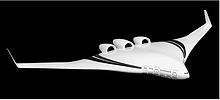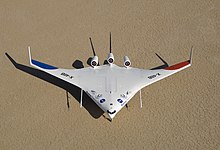Blended wing body
The Blended Wing Body (BWB, in English for "seamless wing-fuselage connection") is an alternative aircraft concept that combines the features of conventional tube-to-wing concepts with those of flying wings . It is characterized by a flattened, aerodynamically shaped fuselage, which can be clearly delimited from the wings, but whose shape merges smoothly into the wing shape. The fuselage has a relevant share in the lift of the aircraft.
history
The precursor to the Blended Wing Body concept can be seen in Hugo Junkers ' flying wing patent from 1910. An early example of an aircraft based on the BWB principle is the Junkers G 38 , in whose “thick wings” not only engines and fuel but also six passengers were accommodated.
At the beginning of the 1920s, the Westland Dreadnought , a passenger aircraft based on this concept, was also built and flown in Great Britain . At the end of the 1930s, Alexander Lippisch developed the DFS 40 , an aircraft in which the fuselage contributed to creating lift.
Current application
Boeing and NASA are currently working under the project name X-48 on researching a BWB (also known as a Hybrid Wing Body (HWB)) for both civil and military purposes. For this purpose, with the X-48B and X-48C, airworthy 1:12 models were built to test the flight characteristics.
Airbus also presented a corresponding concept at the air show in Singapore in 2020: "Maveric" (Model Aircraft for Validation and Experimentation of Robust Innovative Controls). Flight tests have been taking place since summer 2019.
advantages
Possible advantages of this design are:
- a higher efficiency than conventional designs, which should be achieved through a stronger lift (the entire fuselage generates lift) and better aerodynamics
- less noise in the event that the engines are installed above the fuselage
- a lower curb weight
- Fuel economy
disadvantage
Possible disadvantages of this design are:
- the stronger vertical forces acting on passengers and cargo, which with this design tend to be further away from the longitudinal axis of the aircraft
- the lack of or at least a very limited possibility of installing side windows for passengers
- an increased weight and an increased complexity of the aircraft structure, due to the difficulty of designing a non- cylindrical fuselage to be pressure-stable
literature
- Egbert Torenbeek: Blended Wing Body Aircraft: A Historical Perspective. Pp. 63-72, in: Ramesh Agarwal, et al .: Green aviation. Wiley, Chichester 2016, ISBN 978-1-118-86635-1
Web links
- BWB project AC2030
- Blended wing body details (English; PDF file; 172 kB)
- NASA article on the X-48B BWB (English)
Individual evidence
- ↑ Alexander von Vegesack (ed.): Airworld: Design and architecture for air travel . Vitra Design Museum, 2004, ISBN 3-931936-48-1 , p. 120.
- ↑ NASA's futuristic X-48C hybrid wing-body plane takes flight. CNET news of August 7, 2012 (accessed November 3, 2015)
- ↑ Transformed X-48c Flies Successfully. NASA Bulletin 12-259 of August 7, 2012 (accessed November 3, 2015)
- ^ Imagine traveling in this blended wing body aircraft. Airbus SAS, February 11, 2020, accessed on February 11, 2020 .
- ↑ Blended Wing Body: Airbus introduces new aircraft design model. Heise Online, February 11, 2020, accessed on February 11, 2020 .
- ↑ Egbert Torenbeek: Blended Wing Body aircraft: A Historical Perspective . P. 71, in: Ramesh Agarwal, et al .: Green aviation. Wiley, Chichester 2016, ISBN 978-1-118-86635-1




